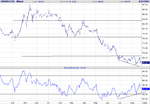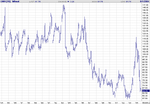News item on Futuresource today :
UK Wheat crop could lose wheat quality : (due to excessive moisture)
DJ U.K. Wheat Crop Could Lose Milling Wheat Quality - Grainfarmers
(Repeating)
LONDON (Dow Jones)--Quality tests over the weekend show a drop of over
100 Hagberg points in the U.K. wheat crop, meaning that over half of the crop
could be below milling wheat quality for the 2004 harvest, U.K. agribusiness
group Grainfarmers said Wednesday.
"Worst hit are crops north of a line from Cambridge to Bedford and
Birmingham (central England). Wheat quality has fallen and is set to
deteriorate further as rain is forecast for the remainder of this week," said
Grainfarmers' wheat director, Gary Sharkey, in a statement.
The group markets roughly 20% of the U.K.'s grain crop and represents
6.17 million hectares.
Sharkey said that farmers have harvested between 20% to 25% of the crop
in those areas and from Yorkshire (northern England) northwards, less than
one field in five has been cut. In Kent and Essex (southern England), roughly
65% have been cut, he said.
Growers are also using every opportunity to get their wheat in the barn,
with some combining crops at 23% to 25% moisture. In this situation, it could
take up to two months to dry down to a marketable moisture. Growers must also
be aware of potential mycotoxin issues, Sharkey said.
Worst hit Group 1 variety appears to be Hereward, which traditionally
loses Hagberg values quicker than Malacca, Grainfarmers said. However, the
Group 2's Solstice, Einstein and Cordiale have performed reasonably well to
date. Those with Cordiale have benefited from early ripening, 4-5 days
behind their Soissons, enabling them to capture a degree of quality, they
said.
The Group 1 premium is around GBP20 per metric ton, they said.
"We could be looking at imports of around 1.1 million to 1.2 million tons
this year in order to satisfy the 5.2 million tons U.K. millers need,"
Sharkey said.
Spot demand for crops harvested in the southern counties have been good,
however, with calls for exports heading to Ireland, the Netherlands and
Germany, he said.
"Mediterranean countries have also taken U.K. grain as they wait for
delayed Black Sea wheat to arrive, but this could dry up over the next 10
days," he said.
Grainfarmers estimates that the U.K. crop could be as high as 16 million
tons, based on current yield levels, but will more likely be closer to 15.2
million tons.
-By Meghan Sapp; Dow Jones Newswires; (4420) 7842 9415;
[email protected]
(END) Dow Jones Newswires
FSN48465 ACT TOP
2004-08-25 12:41:53 UTC



